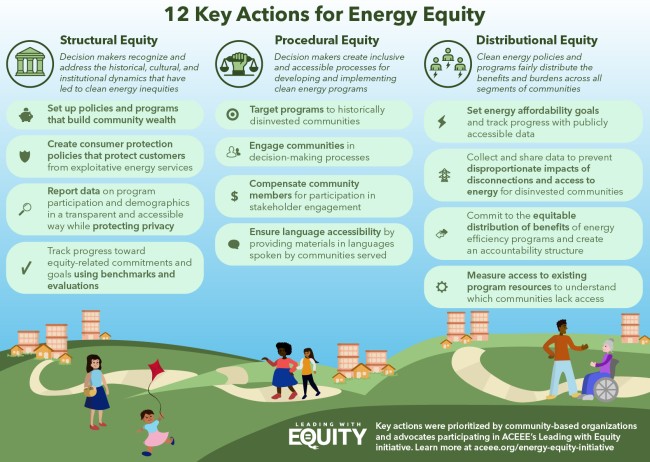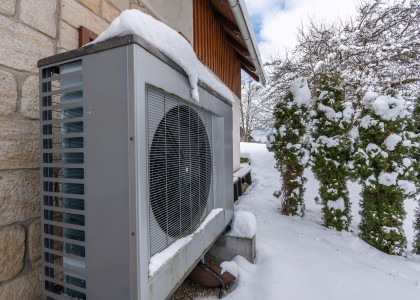Communities of color and low-income communities face disproportionate burdens from climate change, yet too often they aren’t centered in the development of energy policies and programs. ACEEE has heard from community-based organizations (CBOs) and advocates that the vast majority of governments and utilities must better engage with impacted communities, increase access to programs, and ensure their benefits are equitably distributed—while transparently tracking progress.
ACEEE also received feedback that our research needs to better incorporate equity-related considerations to ensure that we’re advocating for an equitable energy future. With that in mind, we’re updating the scoring in our next City, State, and Utility Scorecards—adding new metrics that evaluate progress on these measures—to encourage development of more equitable energy programs. By developing these metrics through a collaborative process with CBOs and advocates, ACEEE is learning how to better be transparent and accountable to partners and to center the expertise of disinvested communities in research methodology and advocacy.
Leading with Equity
ACEEE launched the Leading with Equity (LwE) initiative in 2021 with the goal of driving equitable energy efficiency programs using metrics to hold governments and utilities accountable to the equity-related outcomes of their decisions. Workshops with CBOs, advocates, and utilities in 2021 resulted in a collaborative vision of an equitable energy future and prioritized some of the most important actions for governments and utilities to take. This year, we are focusing on implementing the recommended equity metrics in scorecards. In strategy documents ACEEE published this week, we share our plans for each scorecard.
Input from the Communities Most Impacted Is Essential
Advocates and CBOs emphasized to ACEEE that energy efficiency programs must be widely accessible, deliver benefits based on community or household need, and be developed in consultation with communities. These were among the top priorities highlighted in LwE workshops, shown in the figure below. Three examples of policies or actions that we are considering adding in our scorecards are:
State efforts to remediate health and safety barriers to low-income weatherization. Weatherization programs have baseline requirements for homes they service to ensure the homes are ready for weatherization. For example, homes that have severe moisture and mold or dysfunctional electrical or plumbing systems are often rejected for weatherization assistance. This means people experiencing the most health and safety risks, and thus the most need for these programs, may not be able to access them. The 2022 State Scorecard will include a new metric that gives points to states that have government-supported programs that address health and safety issues to ensure that more households can access weatherization. This metric implements recommendations from LwE workshops with CBOs and advocates to incorporate equitable access to and benefits of energy programs into the scorecards.
State planning processes that include strengthened engagement with environmental justice communities. Though their expertise and lived experience provide invaluable guidance, communities of color, low-income communities, and climate vulnerable communities have often been excluded from processes to develop energy programs. A new metric in the 2022 State Scorecard aims to strengthen states’ procedural equity by giving points to states that engage environmental justice communities in their planning processes, as well as those that have staff dedicated to ensuring equity is centered. This metric is related to the LwE priorities of creating equitable engagement processes and providing language access and compensation for engagement.
Tracking and acting to address energy burden. On average, low-income households pay three times the share of their income on energy as non-low-income households, and Black households have an energy burden 45% higher than white households. In our 2022 State Scorecard, ACEEE looks to implement the LwE recommendations to focus on the equitable distribution of energy program benefits and energy affordability by assessing how states address energy burden. This metric will give states points based on how they set goals for energy affordability and energy burden, track progress toward their goals, and respond to that data in order to decrease energy burden for customers.
Equitable Processes Require Communication and Transparency
In addition to providing valuable data on the most important actions that governments and utilities can take to advance energy equity, this initiative provides lessons in procedural equity. By sharing this process, we hope other organizations looking to advance equity can learn from our experience. This collaborative methodology is new to ACEEE, and we still have a lot to learn. Transparency and accountability are crucial to creating a research process that is more equitable.
We have learned that accountability requires strong communication and responsiveness to feedback we receive. One challenge we face incorporating recommended metrics into the scorecards is making hard decisions about what we can and cannot include in each edition while balancing many objectives and our research capacity. Transparency around these decisions is essential. We need to be specific and report back on changes we did or didn’t make in response to feedback to build trust and make sure our research process is mutually beneficial. For example, if we cannot include a metric because governments or utilities do not have the necessary data, transparently conveying this to CBOs could allow CBOs to advocate for that data collection.
As we move toward embedding equity in our scorecards and other work, we are committed to ensuring the voices of those who have historically been most burdened by the energy system and systems of inequality drive our approach to advocating for a more equitable energy future.





